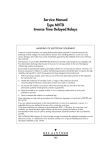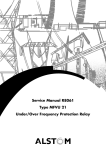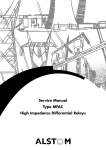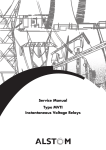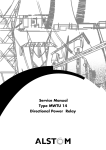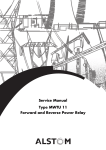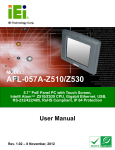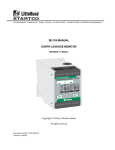Download Type MCGG - ElectricalManuals.net
Transcript
Service Manual Type MCGG Overcurrent Relays for Phase and Earth Faults Service Manual Type MCGG Overcurrent Relays for Phase and Earth Faults HANDLING OF ELECTRONIC EQUIPMENT A person's normal movements can easily generate electrostatic potentials of several thousand volts. Discharge of these voltages into semiconductor devices when handling electronic circuits can cause serious damage, which often may not be immediately apparent but the reliability of the circuit will have been reduced. The electronic circuits of ALSTOM T&D Protection & Control Ltd products are completely safe from electrostatic discharge when housed in the case. Do not expose them to the risk of damage by withdrawing modules unnecessarily. Each module incorporates the highest practicable protection for its semiconductor devices. However, if it becomes necessary to withdraw a module, the following precautions should be taken to preserve the high reliability and long life for which the equipment has been designed and manufactured. 1. Before removing a module, ensure that you are at the same electrostatic potential as the equipment by touching the case. 2. Handle the module by its front-plate, frame, or edges of the printed circuit board. Avoid touching the electronic components, printed circuit track or connectors. 3. Do not pass the module to any person without first ensuring that you are both at the same electrostatic potential. Shaking hands achieves equipotential. 4. Place the module on an antistatic surface, or on a conducting surface which is at the same potential as yourself. 5. Store or transport the module in a conductive bag. More information on safe working procedures for all electronic equipment can be found in BS5783 and IEC 60147-0F. If you are making measurements on the internal electronic circuitry of an equipment in service, it is preferable that you are earthed to the case with a conductive wrist strap. Wrist straps should have a resistance to ground between 500k – 10M ohms. If a wrist strap is not available, you should maintain regular contact with the case to prevent the build up of static. Instrumentation which may be used for making measurements should be earthed to the case whenever possible. ALSTOM T&D Protection & Control Ltd strongly recommends that detailed investigations on the electronic circuitry, or modification work, should be carried out in a Special Handling Area such as described in BS5783 or IEC 60147-0F. TYPES: MCGG22 MCGG42* MCGG52* MCGG53 MCGG62* MCGG63 MCGG82* CONTENTS SAFETY SECTION 5 1. DESCRIPTION 9 2. 2.1 SETTINGS Time delayed element settings 10 10 3. 3.1 3.2 3.3 3.4 INSTALLATION General considerations Relay mounting Unpacking Storage 13 13 13 13 14 4. 4.1 4.2 4.3 COMMISSIONING Commissioning preliminaries Instructions for commissioning the relay on any setting or curve Instructions for commissioning the relay at settings calculated for a particular application 14 14 16 5. 5.1 MAINTENANCE Power supply healthy test 22 22 6. 6.1 6.2 PROBLEM ANALYSIS General Procedure 23 23 23 7. COMMISSIONING TEST RECORD 27 REPAIR FORM 29 Page 4 18 SAFETY SECTION This Safety Section should be read before commencing any work on the equipment. Health and safety The information in the Safety Section of the product documentation is intended to ensure that products are properly installed and handled in order to maintain them in a safe condition. It is assumed that everyone who will be associated with the equipment will be familiar with the contents of the Safety Section. Explanation of symbols and labels The meaning of symbols and labels which may be used on the equipment or in the product documentation, is given below. Caution: refer to product documentation Caution: risk of electric shock Protective/safety *earth terminal Functional *earth terminal. Note: this symbol may also be used for a protective/ safety earth terminal if that terminal is part of a terminal block or sub-assembly eg. power supply. *Note: The term earth used throughout the product documentation is the direct equivalent of the North American term ground. Installing, Commissioning and Servicing Equipment connections Personnel undertaking installation, commissioning or servicing work on this equipment should be aware of the correct working procedures to ensure safety. The product documentation should be consulted before installing, commissioning or servicing the equipment. Terminals exposed during installation, commissioning and maintenance may present a hazardous voltage unless the equipment is electrically isolated. If there is unlocked access to the rear of the equipment, care should be taken by all personnel to avoid electric shock or energy hazards. Voltage and current connections should be made using insulated crimp terminations to ensure that terminal block insulation requirements are maintained for safety. To ensure that wires are correctly terminated, the correct crimp terminal and tool for the wire size should be used. Page 5 Before energising the equipment it must be earthed using the protective earth terminal, or the appropriate termination of the supply plug in the case of plug connected equipment. Omitting or disconnecting the equipment earth may cause a safety hazard. The recommended minimum earth wire size is 2.5 mm2, unless otherwise stated in the technical data section of the product documentation. Before energising the equipment, the following should be checked: Voltage rating and polarity; CT circuit rating and integrity of connections; Protective fuse rating; Integrity of earth connection (where applicable) Equipment operating conditions The equipment should be operated within the specified electrical and environmental limits. Current transformer circuits Do not open the secondary circuit of a live CT since the high voltage produced may be lethal to personnel and could damage insulation. External resistors Where external resistors are fitted to relays, these may present a risk of electric shock or burns, if touched. Battery replacement Where internal batteries are fitted they should be replaced with the recommended type and be installed with the correct polarity, to avoid possible damage to the equipment. Insulation and dielectric strength testing Insulation testing may leave capacitors charged up to a hazardous voltage. At the end of each part of the test, the voltage should be gradually reduced to zero, to discharge capacitors, before the test leads are disconnected. Insertion of modules and pcb cards These must not be inserted into or withdrawn from equipment whilst it is energised, since this may result in damage. Fibre optic communication Where fibre optic communication devices are fitted, these should not be viewed directly. Optical power meters should be used to determine the operation or signal level of the device. Page 6 Older Products Electrical adjustments Equipments which require direct physical adjustments to their operating mechanism to change current or voltage settings, should have the electrical power removed before making the change, to avoid any risk of electric shock. Mechanical adjustments The electrical power to the relay contacts should be removed before checking any mechanical settings, to avoid any risk of electric shock. Draw out case relays Removal of the cover on equipment incorporating electromechanical operating elements, may expose hazardous live parts such as relay contacts. Insertion and withdrawal of extender cards When using an extender card, this should not be inserted or withdrawn from the equipment whilst it is energised. This is to avoid possible shock or damage hazards. Hazardous live voltages may be accessible on the extender card. Insertion and withdrawal of heavy current test plugs When using a heavy current test plug, CT shorting links must be in place before insertion or removal, to avoid potentially lethal voltages. Decommissioning and Disposal Decommissioning: The auxiliary supply circuit in the relay may include capacitors across the supply or to earth. To avoid electric shock or energy hazards, after completely isolating the supplies to the relay (both poles of any dc supply), the capacitors should be safely discharged via the external terminals prior to decommissioning. Disposal: It is recommended that incineration and disposal to water courses is avoided. The product should be disposed of in a safe manner. Any products containing batteries should have them removed before disposal, taking precautions to avoid short circuits. Particular regulations within the country of operation, may apply to the disposal of lithium batteries. Page 7 Technical Specifications Protective fuse rating The recommended maximum rating of the external protective fuse for this equipment is 16A, Red Spot type or equivalent, unless otherwise stated in the technical data section of the product documentation. Insulation class: IEC 61010-1: 1990/A2: 1995 Class I EN 61010-1: 1993/A2: 1995 Class I This equipment requires a protective (safety) earth connection to ensure user safety. Installation Category (Overvoltage): IEC 61010-1: 1990/A2: 1995 Category III EN 61010-1: 1993/A2: 1995 Category III Distribution level, fixed installation. Equipment in this category is qualification tested at 5kV peak, 1.2/50µs, 500Ω, 0.5J, between all supply circuits and earth and also between independent circuits. Environment: IEC 61010-1: 1990/A2: 1995 Pollution degree 2 EN 61010-1: 1993/A2: 1995 Pollution degree 2 Compliance is demonstrated by reference to generic safety standards. Product safety: 73/23/EEC Compliance with the European Commission Low Voltage Directive. EN 61010-1: 1993/A2: 1995 EN 60950: 1992/A11: 1997 Compliance is demonstrated by reference to generic safety standards. Page 8 Section 1. DESCRIPTION The MCGG 22, 42, 52, 62 and 82 are single, two, three or four pole overcurrent relays, with separate measuring boards for each phase or earth fault input. The MCGG 53 and 63 are three pole versions, having their phase inputs combined onto one measuring board. Each pole of the relay provides a choice of four IDMT characteristics and three definite time characteristics. Additionally, each pole is provided with an instantaneous high-set element which can be disabled if not required. The seven versions of the relay covered by this manual are as follows : MCGG 22 Single phase with instantaneous element MCGG 42* Two phase with instantaneous elements MCGG 52* Two phase plus earth fault with instantaneous element MCGG 53 Two phase (with polyphase measurement) plus earth fault with instantaneous elements MCGG 62* Three phase with instantaneous elements MCGG 63 Three phase (with polyphase measurement) with instantaneous element MCGG 82* Three phase plus earth fault with instantaneous elements The rated current of the relay (In) is either 1A or 5A and appears on the module rating label. The relay comprises a case and single plug-in module, which utilises either one or two 28 way terminal blocks. The module is designed with ease of assembly and maintenance in mind, with a switch mode dc-dc converter on a mother-board at the back of the module. This board carries connectors so that printed circuit boards carrying timing/measuring circuitry which can derive IDMT and definite time characteristics can be plugged in. * Refer to ALSTOM T&D Protection and Control Ltd for manual applicable to MCGG 42, 52, 62 and 82 relays with the last four model number digits 0501, 0751 or 1001. Page 9 Section 2. SETTINGS These settings are determined by positioning miniature switches on the relay front panel. There are two groups of switches on each relay pole, the upper group sets the time delayed element, the lower group sets the instantaneous element. Normally, switch settings are only altered during commissioning. If switch setting changes under load are unavoidable, follow the procedure outlined in Section 2.1.6 to minimise the possibility of accidental tripping. 2.1 Time delayed element settings The upper group of switches is sub-divided into three sub-groups which enable the time delayed element to be set. 2.1.1 Time delayed current setting switches, I = ∑ x In The upper seven blue switches are used to set the required current sensitivity setting. Each switch may be positioned to the left or right, the setting level being indicated at the same horizontal level as the switch, to the left or right of the switches or bank of switches. The overall setting is obtained by adding the indicated values of the individual switch settings, and may be set in steps of 5% over the range 0.05 to 2.4 x In. 2.1.2 Curve selection switches The three black switches positioned in the upper group of switches are used to select the required time curve from the choice of four inverse time and three definite time curves. The characteristic curve equations are listed below. The eighth switch combination sets the relay into the ‘trip test’ mode. Switch Position 0 SI Standard inverse VI Very inverse EI Extremely inverse LTI Long time inverse t= t= t= t= 0.14 (I0.02 – 1) 13.5 (I – 1) 80 – 1) (I2 120 (I – 1) Page 10 s s s s 1 0 0 <- - <- - - 0 <- - - 1 0 - - -> <- - - 0 <- - - 0 1 <- - - - -> 0 <- - - 1 1 - - -> - - -> 0 <- - - Where I is the ratio of the applied current to the setting current Is. D2 Definite time 2s D4 Definite time 4s D8 Definite time 8s Trip test Note: 2.1.3 0 <- - - 0 <- - - 1 - - -> 1 - - -> 0 <- - - l - - -> 0 <- - - 1 - - -> 1 - - -> 1 - - -> 1 - - -> 1 - - -> It is recommended that visual indication of the curve selected is made by marking the appropriate square(s) provided for each (use the pegs provided on earlier relays). Time multiplier setting switches x t = ∑ Six blue switches positioned at the bottom of the upper switch group are used to set the required time multiplier. The time given by each of the time delayed operating characteristics must be multiplied by the time multiplier to give the actual operating time of the relay pole. The setting is obtained by adding the indicated values of the individual switch settings and is indicated by x t = ∑. Note: 2.1.4 Although it is possible to set the switches to give a TMS of 0.025x t, this setting cannot be guaranteed to give specified accuracy. Therefore only settings in the range 0.05 to 1.0 x t should be used. Instantaneous element setting Iinst = ∑ x Is The lower separate group of six blue slider switches is used to select the required instantaneous current settings between 1 x Is and 31 x Is. The selected setting is obtained by adding the indicated values of the individual switch settings. This value multiplied by the time delayed current setting gives the operating current of the instantaneous element. If the instantaneous element on the relay pole is not required, then the switches should all be set to the left (indicating zeros), or the bottom switch should be set to the right (indicating infinity). Page 11 2.1.5 Relay setting example In this case:– Current setting switches 0.1 0.1 0.2 0.4 0.4 0.4 0.8 <- <- <- - -> - -> - -> <- - 0.05 Is 0 0 0 Is = ∑ x In 0 0 0 Curve select switches 0 0 0 <- <- <- - 1 1 1 TMS switches 0.025 0 0 0 0 0 - -> - -> <- <- <- - -> 0.05 0.05 0.1 0.2 xt=∑ 0.2 0.4 0 0 0 0 0 0 <- - -> <- - -> <- <- - 1 2 4 8 16 ∞ Instantaneous current setting switches = (0.1 + 0.1 + 0.2 + 0.8) x In = 1.2 x In Standard inverse curve TMS = (0.05 + 0.05 + 0.4)x = 0.5x Iinst = (8 + 2) x Is Iinst = ∑ x Is = 10 x 1.2 x In = 12 x In If the above settings were applied to a 1A relay Current setting = 1.2A Curve = Standard Inverse TMS = 0.5 x Instantaneous current setting = 12A (Currents are secondary values.) 2.1.6 Procedure for resetting the MCGG DIL switches in service Normally settings are changed with the ac input and/or the dc auxiliary supply disconnected during commissioning at the required setting. If either the current setting (Is) or the highset threshhold setting (Iinst) has to be altered in service then, to minimise the likelihood of any resultant tripping, the following procedure should be adopted: 1. Temporarily disable the highset element by moving the Iinst 0/∞ switch from the left (0) to the right (infinity) position. 2. Increase the Is current setting to the maximum by moving all Is switches to left hand positions. Set the new setting current by moving to the right the switches required to achieve the new setting. This ensures that an intermediate Is value lower than the load current is not accidentally applied, resulting in operation of either the highset or the IDMT element. Page 12 3. Move the highset (Iinst) switches to the new setting required. 4. Re-enable the highset element by moving the Iinst 0/∞ switch from the infinity (right) to the 0 (left) position. Note that the TMS switches and the black curve select switches can be moved at any time when the load current is less than the setting current (ie. when the green LED is off) without affecting operation. Section 3. 3.1 INSTALLATION General considerations Protective relays, although generally of robust construction, require careful treatment prior to installation on site. Upon receipt, relays should be examined immediately, to ensure no damage has been sustained in transit. When handling a relay, great care must be taken, particularly when the relay is removed from its case. Touching the printed circuit board should be avoided, since metal oxide semiconductor (MOS) devices are used, which can be damaged by static electricity discharges from the body. If damage has been sustained in transit, a claim should be made to the transport contractors and ALSTOM T&D Protection and Control Ltd should be promptly notified. Relays which are supplied unmounted and not intended for immediate installation should be returned to their protective polythene bags. 3.2 Relay mounting Relays are despatched either individually or as part of a panel/rack mounted assembly. If the relays are to be installed into a panel/rack assembly after receipt, then construction details can be found in Publication R7012. 3.2.1 When the MCGG is used in conjunction with other ALSTOM T&D Protection and Control Ltd relays, the following guidelines should be followed for positioning the relays in the modular assembly : (1) Test facilities: MMLG test block should be positioned at the right of the tier. (2) Current relays: MCGG overcurrent relay should be adjacent to test block. (3) Directional control: METI directional relay should be adjacent to, and to the left of the MCGG relay it is controlling. (4) Other relays: Any other relays required for the relay scheme, should be positioned to the left of the tier viewed from the front. 3.2.2 For individually mounted relays, an outline diagram is normally supplied showing panel cut-outs and hole centres, these dimensions will also be found in Publication R6054. 3.3 Unpacking Care must be taken when unpacking and installing the relays so that none of the parts is damaged or their settings altered and they must at all times be handled by skilled persons only. The installation should be clean, dry and reasonably free from dust and excessive vibration. The site should be well lit to facilitate inspection. Page 13 Relays which have been removed from their cases should not be left in situations where they are exposed to dust or damp. This particularly applies to installations which are being carried out at the same time as constructional work. 3.4 Storage If relays are not installed immediately upon receipt they should be stored in a place free from dust and moisture in their original cartons and where de-humidifier bags have been included in the packing they should be retained. The action of the de-humidifier crystals will be impaired if the bag has been exposed to ambient conditions and may be restored by gently heating the bag for about an hour, prior to replacing it in the carton. Dust which collects on a carton may, on subsequent unpacking, find its way into the relay; in damp conditions the carton and packing may become impregnated with moisture and the de-humidifying agent will lose its efficiency. Storage temperature –25° to +70°C. Section 4. COMMISSIONING 4.1 Commissioning preliminaries 4.1.1 Inspection Carefully examine the module and case to see that no damage has occurred since installation and visually check that any current transformer shorting switches are wired into the correct circuit and are closed with the module withdrawn. Check that the relay serial number on the module, case and cover are identical and that the model number or rating information is correct. 4.1.2 Wiring Check that the external wiring is correct to the relevant relay diagram or scheme diagram. The relay diagram number appears inside the case. 4.1.3 Insulation Isolate all wiring from earth and test the insulation of the external wiring with an electronic or brushless insulation tester at dc voltage not exceeding 1000V. Terminals of the same circuit should be temporarily strapped together. The directional control circuits are isolated from all other circuits but are electrically connected to the relay case. These circuits must not therefore, be insulation or impulse tested to the case. 4.1.4 Electrostatic discharges (ESD) The relay uses components which are sensitive to electrostatic discharges. When handling the module, care should be taken to avoid contact with components and electrical connections. When removed from the case for storage, the module should be placed in an electrically conducting anti-static bag. See full recommendations inside front cover. 4.1.5 Earthing Ensure that the case earthing connection above the rear terminal block is used to connect the relay to a local earth bar. Page 14 4.1.6 Main current transformers DO NOT OPEN THE SECONDARY CIRCUIT OF A LIVE CT SINCE THE HIGH VOLTAGE PRODUCED MAY BE LETHAL TO PERSONNEL AND COULD DAMAGE INSULATION. 4.1.7 Test block type MMLG If test block type MMLG is provided, the connections should be checked to the scheme diagram, particularly that the supply connections are to the ‘live’ side of the test block (coloured orange) and with terminals allocated with odd numbers (1, 3, 5, 7 etc.) and also that the dc connection is routed via test block terminals 13 and 15. 4.1.8 Terminal allocation Reference should be made to the diagram supplied with every relay. 4.1.9 Test equipment required: Overcurrent test set with timing facilities Multifinger test plug type MMLB 01 for use with test block type MMLG when required Calibrated multimeter 0 – 10A ac 0 – 250V dc 4.1.10 General Secondary injection commissioning tests should be carried out using a portable single phase overcurrent test equipment, preferably injected via test block type MMLG. It is most important that the test equipment is capable of injecting an undistorted sinusoidal current waveform. 4.1.11 DC supply Remove the relay module from its case. The incoming supply should be checked at the relay case terminals. Relay case terminal 13 should be positive with respect to terminal 14 and the incoming voltage must be within the operative range specified below. DC rating (V) Operative range (V) 24/54 48/125 110/250 19 – 60 37.5 – 150 87.5 – 300 CAUTION: The relay is designed to withstand an ac ripple component of up to ±12% of the nominal dc auxiliary supply voltage. However, in all cases the peak value of the dc supply must not exceed the maximum specified operating limit. Operation of the supply battery charger with the batteries disconnected could cause damage due to overvoltage. 4.1.12 Relay CT shorting switches With the relay removed from its case, check that each CT shorting switch is closed by injecting rated current into each phase circuit. The rated current of the relay (In) is either 1A or 5A and appears on the module rating label. Page 15 4.1.13 Energise relay For secondary injection testing using test block type MMLG, insert test plug type MMLB 01 with the required main CT shorting links fitted. It may then be necessary to link across the front of the test plug to restore the dc supply to the relay. Isolate the relay trip contacts and insert the module. Ensure that the curve selection switches on each pole are set to any position except 111. Connect the dc supply to the relay. The relay has a non-volatile memory which remembers the state (ON or OFF) of the LED trip indicators when the relay was last powered, and therefore some or all of the indicators may be illuminated. Press the RESET button and check that the LEDs on all of the poles are illuminated. Release the RESET button and check that the LEDs reset. Note: To commission the relay with the settings and curve required for the particular application, omit Section 4.2 and proceed directly to Section 4.3. If the settings/curve will be altered by the user without re-commissioning the relay, complete the tests in both Sections 4.2 and 4.3. 4.2 Instructions for commissioning the relay on any setting or curve 4.2.1 Current sensitivity switches (Is = ∑ x In) This test checks that each of the front panel current selector switches operates correctly. The green relay start LED provided on the front panel gives indication when the input current exceeds the setting current Is. Inject single phase current into a phase circuit and slowly increase the current until the start LED lights. Repeat the test for each switch in turn and check that the pick up current is within the range shown in Table 4.1 Switch selections: Current Curve TMS Instantaneous (Is = ∑ x In) ) ( (x t = ∑) (Iinst = ∑ x Is) Is ( x In) AC current operate level (amps) In = 1A In = 5A 0.05 0.10 0.15 0.25 0.45 0.45 0.45 0.85 0.05 0.10 0.15 0.25 0.45 0.45 0.45 0.85 - 0.055 - 0.110 - 0.165 - 0.275 - 0.495 - 0.495 - 0.495 - 0.935 0.25 0.50 0.75 1.25 2.25 2.25 2.25 4.25 - : : : : as shown any any any 0.275 0.550 0.825 1.375 2.475 2.475 2.475 4.675 Table 4.1 Note: 1. The above current levels make no allowance for errors in measurement of the ac current amplitude 2. The reference range for MCGG 22, 42, 52, 62 and 82 relays is 0.05In to 2.4In 3. The reference range for MCGG 53, 63 relays is 0.2In to 2.4In These tests should be repeated for each pole of the relay. Page 16 4.2.2 Curve selection switches ( ) Connect the relay time delayed output contacts to both trip the test set, and to stop a timer. Inject single phase current into the pole under test at a current level of 10 x rated current. Check that the operating time for the relay for each curve setting is within the range shown in Table 4.2. Switch selections: Current Curve TMS Instantaneous Selected curve SI VI EI LTI D2 D4 D8 (Is = ∑ x In) ( ) (x t = ∑) (Iinst = ∑ x Is) : : : : 1 x In as shown 1xt ∞ Operating time range at 10 x Is (seconds) Nominal Range Standard inverse Very inverse Extremely inverse Long time inverse Definite time 2s Definite time 4s Definite time 8s 2.97 1.50 0.808 13.3 2.00 4.00 8.00 2.82 1.42 0.747 12.6 1.94 3.88 7.76 – – – – – – – 3.12 1.58 0.869 14.0 2.06 4.12 8.24 Table 4.2 Note: The above operating time ranges make no allowance for errors in measurement of the ac current amplitude. These tests should be repeated for each pole of the relay. 4.2.3 Time multiplier setting switches (x t = ∑) Connect relay time delayed output contacts to both trip the test set and to stop a timer. Inject single phase current into the pole under test at a current level of 10 x rated current. Measure the operating time on the SI curve at the TMS switch positions shown in Table 4.3. Switch Selections: Current Curve TMS Instantaneous TMS value 0.125 x t 0.2 x t 0.9 x t (Is = ∑ x In) ( ) (x t = ∑) (Iinst = ∑ x Is) : : : : 1 x In SI standard inverse as shown ∞ Operating time range at 10 x In (seconds) Nominal Range 0.371 0.594 2.67 0.322 – 0.42 0.534 – 0.654 2.48 – 2.87 Table 4.3 Note: The above operating time ranges make no allowance for errors in measurement of the ac current amplitude. These tests should be repeated for each pole of the relay. Page 17 4.2.4 Instantaneous current setting switches (Iinst = ∑ x Is) WARNING THE RELAY MAY BE DAMAGED BY APPLYING EXCESSIVE CURRENT FOR LONG DURATIONS DURING TESTING. IT IS IMPORTANT TO FOLLOW THE INSTRUCTIONS PRECISELY. The following test checks that the instantaneous current switches are operative. The instantaneous trip output contacts must be connected to trip the test set. It is recommended that the time delay element is set to operate in 4s and that the time delay output contacts are also wired to trip the test set, to prevent relay damage if current is applied for too long. The current level should be set and then suddenly applied; DO NOT INCREASE THE CURRENT SLOWLY since this may damage the relay. The test must be repeated for each of the switch positions shown in Table 4.4 initially at a higher current level to check that the instantaneous element operates and then at a lower level, at which the element should not trip. Switch selections: Instantaneous value Current Curve TMS Instantaneous (Is = ∑ x In) ( ) (x t = ∑) (Iinst = ∑ x Is) : : : : Current level (A) In = 5A In = 1A 0.5 x In D4 definite time 4s 1xt as shown Iinst response 1 x Is 0.55 0.50 2.75 2.5 Trip No trip 2 x Is 1.05 0.95 5.25 4.75 Trip No trip 4 x Is 2.1 1.9 10.5 9.5 Trip No trip 8 x Is 4.2 3.8 21.0 19.0 Trip No trip 16 x Is 8.4 7.6 42.0 38.0 Trip No trip Table 4.4 Note: The above current ranges make no allowance for errors in measurement of the ac current amplitude. These tests should be repeated for each pole of the relay. 4.3 Instructions for commissioning the relay at settings calculated for a particular application 4.3.1 General If there is any possibility that the relay settings are to be changed during the life of the relay without re-commissioning, then the instructions in Section 4.2 should be completed initially. Ensure that the main system current transformers are shorted before isolating the relay from the current transformers in preparation for secondary injection tests. Page 18 4.3.2 Relay CT shorting switches If not previously checked, and with the relay module removed from its case, check that each CT shorting switch is closed by injecting rated current into each phase circuit. The rated current of the relay (In) is either 1A or 5A and appears on the module rating label. 4.3.3 Energise relay Connect the dc supply to the relay and record the dc voltage at terminals 13 (+ve) and 14. 4.3.4 Trip test Set the curve selection switches to 111 (test mode), on one pole of the relay. Check that the LEDs associated with that pole of the relay flash at a frequency of approximately once per second. Press and hold the RESET button. The LEDs of the other poles of the relay should illuminate continuously, whilst those of the pole under test should continue to flash. After approximately 6 seconds, the time delayed and instantaneous output elements associated with the pole under test should trip and at the same time, the LEDs should then illuminate continuously on that pole. Release the RESET button. The output elements should reset. Change the curve selection switches from 111 (test mode) to 101 (4s definite time), and repeat the test on the other poles of the relay. 4.3.5 Instantaneous current settings (Iinst = ∑ x Is) WARNING THE RELAY MAY BE DAMAGED BY APPLYING EXCESSIVE CURRENT FOR LONG DURATIONS DURING TESTING. IT IS IMPORTANT TO FOLLOW THE INSTRUCTIONS PRECISELY. This test is to check that the instantaneous current level as set, is correct. The instantaneous trip output contacts must be connected to trip the test set. It is recommended that the time delay element is set to operate in 4s and that the time delay output contacts are also connected to trip the test set, to prevent relay damage if current is applied for too long. The current level should be set and then suddenly applied; DO NOT INCREASE THE CURRENT SLOWLY since this may damage the relay. Two tests, shown in Table 4.5 below, are specified for the particular x Is setting required for the application. Initially the higher current level should be applied to check that the instantaneous element operates and then the lower current level should be applied to check that no trip occurs. Switch selections: Current Curve TMS Instantaneous (Is = ∑ x In) ( ) (x t = ∑) (Iinst = ∑ x Is) Page 19 : : : : 0.5 x In D4 definite time 4s 1xt As specified for the application Instantaneous setting (x Is) 1 2 3 4 5 6 7 8 9 10 11 12 13 14 15 16 17 18 19 20 21 22 23 24 25 26 27 28 29 30 31 Current level (A), In = 1A No trip Iinst Trip Iinst 0.50 0.95 1.4 1.9 2.3 2.8 3.3 3.8 4.2 4.7 5.2 5.7 6.1 6.6 7.1 7.6 8.0 8.5 9.0 9.5 9.9 10.4 10.9 11.4 11.8 12.3 12.8 13.3 13.7 14.2 14.7 0.55 1.05 1.6 2.1 2.7 3.2 3.7 4.2 4.8 5.3 5.8 6.3 6.9 7.4 7.9 8.4 9.0 9.5 10.0 10.5 11.1 11.6 12.1 12.6 13.2 13.7 14.2 14.7 15.3 15.8 16.3 Current level (A), In = 5A No trip Iinst Trip Iinst 2.5 4.75 7.1 9.5 11.8 14.2 16.6 19 21 23 26 28 30 33 35 38 40 42 45 47 49 52 54 57 59 61 64 66 68 71 73 2.75 5.25 7.9 10.5 13.2 15.8 18.4 21 24 27 29 32 35 37 40 42 45 48 50 53 56 58 61 63 66 69 71 74 76 79 82 Table 4.5 Note: The above current levels make no allowance for errors in measurement of the ac current amplitude. This test should be repeated for each pole of the relay. 4.3.6 Instantaneous element operating time It is not recommended that the instantaneous element operating time is checked, due to the possibility of damage to the relay. The tests of section 4.3.5 and the previous works tests provide adequate assurance that the operating time is correct. Page 20 4.3.7 Curve selection ( ) The following test checks the selected curve characteristic at specified points. WARNING THE TEST EQUIPMENTS THERMAL LIMIT MAY BE EXCEEDED IF THE LONG TIME INVERSE CURVE IS SELECTED. Connect the relay time delayed output contacts to both trip the test set, and to stop a timer. Inject single phase current into a convenient phase of each separate time delay element at the current levels specified below for the particular curve selection specified for the application. Check that the operating time for the relay is within the range shown in Table 4.6 below. Table 4.6 details the inverse time operating time curves at 2 x, 5 x, 10 x and 20 x Is. It is recommended that results are recorded at 10 x followed by 2 x Is, the others are listed in case they are specifically requested by the user. Definite time characteristics should be checked at 2 x Is only. Switch selections: Current Curve TMS Instantaneous Curve 2 x Is Nom. Range SI VI EI LTI D2 D4 D8 10.03 13.50 26.7 120 2.00 4.00 8.00 9.52 - 10.6 12.8 - 14.2 24.6 - 28.7 114 - 126 1.94 - 2.06 3.88 - 4.12 7.76 - 8.24 (Is = ∑ x In) ( ) (x t = ∑) (Iinst = ∑ x Is) : : : : 1 x In As specified for the application 1xt As specified for the application Operating time at specified current (seconds) 5 x Is 10 x Is Nom. Range Nom. Range Nom. 4.28 3.38 3.33 30.0 2.27 0.711 0.201 6.32 4.06 - 4.50 3.20 - 3.55 3.08 - 3.59 28.5 - 31.5 2.97 1.50 0.808 13.3 2.82 - 3.12 1.42 - 1.58 0.747 - 0.869 12.6 - 14.0 20 x Is Range 2.15 - 2.38 0.675 - 0.746 0.170 - 0.231 6.00 - 6.64 Table 4.6 Note: The above operating time ranges make no allowance for errors in measurement of the ac current amplitude. These tests should be repeated for each pole of the relay. 4.3.8 Current sensitivity setting (Is = ∑ x In) This test checks the sensitivity of the relay at the selected setting. The green relay start LED provided on the front panel gives indication when the input current exceeds the setting current Is. Switch selections: Current Curve TMS Instantaneous (Is = ∑ x In) ( ) (x t = ∑) (Iinst = ∑ x Is) : : : : As specified for the application As specified for the application 1xt As specified for the application Slowly increase the applied single phase current until the start LED lights. The minimum value of current to cause the start LED to light should be recorded. Page 21 This level should be greater than 1 x Is x In and less than 1.1 x Is x In Note: These levels make no allowance for errors in measurement of the ac current amplitude. These tests should be repeated for each phase of the relay. 4.3.9 Operating time at final selected settings The relay switches should be set to the specified settings and the operating time of the time delay circuit (t) should be measured at 2 x Is. The measured time should be within ±5% or 40ms of the value computed from the previous time measured at 2 x Is (in test 4.3.8) multiplied by selected TMS settings. Switch selection: Current Curve TMS Instantaneous (Is = ∑ x In) ( ) (x t = ∑) (Iinst = ∑ x Is) As specified for the application Repeat test 4.3.9 for each pole of the relay. 4.3.10 Final check Carefully check that the LED indicators and relay output contacts are all operating correctly and that with the relay front cover replaced, the reset button satisfactorily operates/resets the LEDs. If required, check that the relay output contacts trip the circuit breaker, connect the relay through to the main CTs and remove the CT shorts. Section 5. MAINTENANCE Periodic maintenance is not required; however, periodic inspection and test is advisable. It is recommended that the power supply healthy test outlined below is carried out at regular intervals. 5.1 Power supply healthy test The availability of power to the measuring boards can be checked at any time without removing the protection provided by the relay. This is done by pressing the reset button on the front panel. All LEDs should illuminate if the relay is performing satisfactorily. When the pushbutton is released, all the LEDs should be extinguished. Page 22 Section 6. 6.1 PROBLEM ANALYSIS General These instructions enable a fault to be located to sub-assembly level. Fault finding at component level is not recommended. The major reasons for this are as follows : (1) Fault finding on printed circuit boards (pcbs) requires specialised knowledge and equipment. (2) Components used in manufacture are subjected to strict quality control procedures and in certain cases selected for particular characteristics. Metal oxide semiconductor (MOS) components are used which require very careful handling. (3) Damage can be caused to printed circuit board track unless extreme care is used in replacement of components. (4) Replacement of certain components will require recalibration of the relay. In the event of a faulty sub-assembly being found, it is recommended that the relay is returned to ALSTOM T&D Protection and Control Ltd or sent to a competent service centre for the work to be carried out. However, replacement sub-assemblies can be made available from ALSTOM T&D Protection and Control Ltd upon request, provided the relay model number and serial number are quoted. Recalibration of the relay is not required after the replacement of a sub-assembly. Note: 6.2 Before fault finding on the relay is commenced, all external connections and supplies to the relay should be checked to ensure that the fault lies within the relay. Procedure The following tests should only be carried out under laboratory conditions, when a faulty relay has been identified and removed from its case. 6.2.1 Gaining access to the relay internal circuitry The method for removing the frontplate on the Series 2 MCGG varies according to the date at which the relay was supplied. The earliest types are identified by the presence of one pozidrive type screw in both the top and bottom plate of the module towards the left-hand side, adjacent to the frontplate. To remove the frontplate on this type, firstly remove the plastic handle strips from the module handles to expose the two screws which secure the relay frontplate to the module. These are located to the right-hand side of each handle and are recessed so that their heads lie flush with the relay frontplate. Remove these two screws, together with the two pozidrive screws mentioned above to release the frontplate. Later types are not fitted with the two pozidrive type screws fitted in the top and bottom plate of the module. To remove the frontplate on this type, firstly remove the plastic handle strips from the module handles. Next, remove all the screws which secure the handles to the frontplate. With the handles removed, remove the two remaining screws to release the frontplate. Page 23 On all versions of the MCGG 22, remove the handle strips followed by the handle securing screws. Finally, with the handles removed, unscrew the remaining two screws to release the frontplate. With the frontplate freed from the rest of the module, tension on the wires to the flag reset switch should be avoided. If necessary, the switch can be unscrewed from the frontplate. The latest types utilize clip-in type moulded handles. The black frontplate securing screws are of the pozidrive type and are directly accessible without removing the handles. Removal of these screws will release the frontplate. On these types, the reset switch is not attached to the frontplate. The measuring/timing PCBs can now be accessed as required. 6.2.2 DC internal power supply check This can easily be done by pressing the reset button on the front panel. All LEDs should illuminate if all measuring boards are operating satisfactorily. Upon releasing the push-button, all LEDs should be extinguished. Note: 6.2.3 This test may be carried out at any time whilst the relay is in service without affecting its ability to measure or trip. Output relay trip test Set the curve selection switches on each measuring board, in turn, to the ‘111’ position. This should result in the three LEDs on that measuring board flashing at a rate of one per second. If the reset bushbutton is then held pressed for approximately six seconds, both output relays associated with that measuring board should energise, the LEDs will stop flashing and remain in the on state until the push button is released. In this way each measuring board, the associated output relays and their changeover contacts can each be checked individually without the need for any input current being applied. Output miniature relays are an integral part of the module’s mother board, so in the event of such a unit failing, the whole relay should be returned to ALSTOM T&D Protection and Control Ltd for repair. Note: 6.2.4 During this test, current transformer measurement is inhibited. AC input tests If one or more poles of the relay are inoperative, the input transformer for that relay should be tested. For this test a current source capable of delivering 2x rated current to the relay, and an ac ammeter, are required. The current should be applied to each current input of the relay in turn and the ammeter should be used to measure the current flowing from the directional control terminals for that particular pole of the relay. With 2x rated current applied to the relay input (2A or 10A) the current measured at the directional control terminals should be 20mA ± 10%. Page 24 Relay type Apply 2x rated current to terminals (2A or 10A) Measure 20mA ± 10% at terminals MCGG22 27 and 28 23 and 24 MCGG42 21 and 22 25 and 26 49 and 50 45 and 46 MCGG52 21 and 22 25 and 26 27 and 28 49 and 50 45 and 46 43 and 44 MCGG53 21 and 22 27 and 28 49 and 50 43 and 44 MCGG62 21 and 22 23 and 24 25 and 26 49 and 50 47 and 48 45 and 46 MCGG63 21 and 22 49 and 50 MCGG82 21 23 25 27 49 47 45 43 and and and and 22 24 26 28 and and and and 50 48 46 44 If 20mA is not obtained at the directional control terminals, then firstly the relay wiring must be checked, both at the module contact moulding and at the pcb connectors. If these are sound, then the input transformer of the faulty pole must be replaced. 6.2.5 Measuring/timing circuitry tests In the event that one or more poles of the relay is found to be inoperative and the power supply and input transformer have been proved to be working correctly, then the measuring/timing pcb (ZJ0091 on earlier versions, ZJ0161 on later versions) must be suspected. In order to establish that this pcb is faulty, a ‘known-good’ pcb should be moved from another position in the module, and tested in the position where the suspect pcb had failed to work. Section 6.2.1 describes how to gain access to the measuring boards. The measuring boards to be interchanged should gently be pulled out from the mother board. When the measuring boards are replaced, care should be taken to ensure that their connecting pins are correctly aligned with the rear socket. See notes 1 and 2 below. If this pcb works satisfactorily in this position, it can be assumed that the suspect pcb is faulty and should be replaced. If, however, this pcb does not work either, the mother-board should be suspected necessitating that the whole relay should be returned to ALSTOM T&D Protection and Control Ltd for repair. Note 1: Under no circumstances should current be injected into any of the relay inputs when the corresponding measuring/timing pcb has been removed from the module. Note 2: At least one of the measuring/timing pcbs must be located in the module when the dc auxiliary supply is connected to the module or damage to the power supply circuitry may result. Page 25 Page 26 Section 7. COMMISSIONING TEST RECORD Multifunction Overcurrent Relay Type MCGG Serial No ................................... Relay Model Number MCGG .................................... Date .......................................... Station..................................................................... Circuit ....................................... Relay Type 1 Phase ......................... 2 Phase ........................ 3 Phase ........................... 2 Phase + Earth Fault ............................................ 3 Phase + Earth Fault ............................................ Rated current In DC voltage 1A ............................... 5A ................................. 24/54V ..................... 48/125V .................... 110/250V ........................... Final switch settings Phase A: Phase B: Phase C: Earth fault: Current sensitivity curve TMS Instantaneous element Is x In Iinst x Is Current sensitivity curve TMS Instantaneous element Is x In Iinst x Is Current sensitivity curve TMS Instantaneous element Is x In Iinst x Is Current sensitivity curve TMS Instantaneous element Is x In Iinst x Is Page 27 Test results 4.1.13 Energisation test ................................ 4.3.2 Relay CT shorting switches ................................ 4.3.3 DC supply voltage ................................ 4.3.4 Trip test ................................ 4.3.5 Current level to trip Iinst (A) Phase A Phase B Phase C E.F. ........................ ....................... ........................ ....................... Current level NOT to trip Iinst (A) 4.3.7 Phase A Phase B Phase C E.F. ........................ ....................... ........................ ....................... Operating time on selected curve(s) Curve ...................... 4.3.8 Phase A Phase B Phase C E.F. ........................ ....................... ........................ ....................... 10 x Is ....................... ....................... ........................ ....................... 2 x Is ....................... ....................... ........................ ....................... Current sensitivity at selected setting Is (A) Is .................................. 4.3.9 Phase A Phase B Phase C E.F. ........................ ....................... ........................ ....................... Phase B Phase C E.F. ....................... ........................ ....................... Operating time at final selected setting(s) TMS ....................... Phase A 2 x Is ........................ _____________________________________ ______________________________________ Commissioning Engineer Customer Witness _____________________________________ ______________________________________ Date Date Page 28 REPAIR FORM Please complete this form and return it to ALSTOM T&D Protection and Control Ltd with the equipment to be repaired. This form may also be used in the case of application queries. ALSTOM T&D Protection and Control Limited St. Leonards Works Stafford ST17 4LX, England For: After Sales Service Department Customer Ref: ___________________________ Model No: __________________ Contract Ref: ___________________________ Serial No: Date: ___________________________ 1. __________________ What parameters were in use at the time the fault occurred? AC volts _____________ Main VT/Test set DC volts _____________ Battery/Power supply AC current _____________ Main CT/Test set Frequency _____________ 2. Which type of test was being used? ____________________________________________ 3. Were all the external components fitted where required? (Delete as appropriate.) 4. List the relay settings being used Yes/No ____________________________________________________________________________ ____________________________________________________________________________ ____________________________________________________________________________ 5. What did you expect to happen? ____________________________________________________________________________ ____________________________________________________________________________ ____________________________________________________________________________ ____________________________________________________________________________ continued overleaf ✁ Page 29 6. What did happen? ____________________________________________________________________________ ____________________________________________________________________________ ____________________________________________________________________________ ____________________________________________________________________________ 7. 8. When did the fault occur? Instant Yes/No Intermittent Yes/No Time delayed Yes/No (Delete as appropriate). By how long? ___________ What indications if any did the relay show? ____________________________________________________________________________ ____________________________________________________________________________ ____________________________________________________________________________ 9. Was there any visual damage? ____________________________________________________________________________ ____________________________________________________________________________ ____________________________________________________________________________ 10. Any other remarks which may be useful: ____________________________________________________________________________ ____________________________________________________________________________ ____________________________________________________________________________ ______________________________________ Signature _______________________________________ Title ______________________________________ Name (in capitals) _______________________________________ Company name ✁ Page 30 Page 31 A L S T O M T & D P r o t e c t i o n & C o n t r o l L t d St Leonards Works, Stafford, ST17 4LX England Tel: 44 (0) 1785 223251 Fax: 44 (0) 1785 212232 Email: [email protected] Internet: www.gecalsthomgpc.co.uk ©1998 ALSTOM T&D Protection & Control Ltd Our policy is one of continuous product development and the right is reserved to supply equipment which may vary from that described. Publication R8054J Printed in England.
































